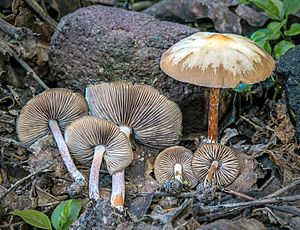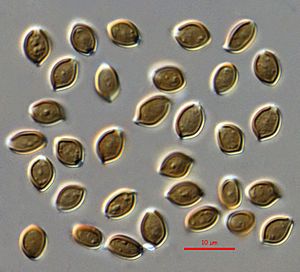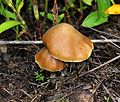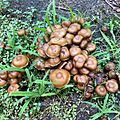Landslide mushroom facts for kids
Quick facts for kids Landslide mushroom |
|
|---|---|
 |
|
| Scientific classification | |
| Genus: |
Psilocybe
|
| Species: |
caerulescens
|
| Synonyms | |
|
P. caerulescens ssp. caerulescens var. albida |
|
| Psilocybe caerulescens | |
|---|---|
| Mycological characteristics | |
| gills on hymenium | |
| cap is convex | |
| hymenium is adnate or sinuate | |
| stipe is bare | |
| spore print is purple-brown | |
| ecology is saprotrophic | |
| edibility: psychoactive | |
Psilocybe caerulescens, often called the landslide mushroom, is a special type of mushroom. Its Spanish name, "derrumbe," also means landslide. This mushroom was likely used by the ancient Aztec people. Today, it is still used by Mazatec shamans in their traditional ceremonies. Other mushrooms like Psilocybe mexicana and Psilocybe aztecorum were also important in these cultures.
About the Mushroom
The Psilocybe caerulescens mushroom has a strong, flour-like taste and smell. Some people say it smells like cucumber. This smell becomes less noticeable as the mushroom gets older or when it dries out.
The Cap
The top part of the mushroom, called the cap, is usually 3 to 7 centimeters wide. Sometimes it can be as small as 1 cm or as large as 10 cm. It starts out rounded or bell-shaped with its edge curved inward. The cap rarely becomes flat. It often has a small bump in the middle or a slight dip.
When the cap is wet, it feels sticky because of a thin, jelly-like layer that can be peeled off. The edge of the cap looks slightly striped when wet. The cap changes color depending on how much moisture is in the air. It can be yellowish-brown to reddish-brown. It also has a shiny, silvery-blue metallic look. The edges are usually lighter in color. As it dries, the cap turns a beige or straw yellow color.
If you touch or handle the mushroom, it quickly turns blue. Younger mushrooms might even turn bluish-green or almost black. The cap's color and shape can vary a lot from one mushroom to another.
The Gills
Underneath the cap are the gills. These are attached to the stem and are close together. When they are young, the gills are whitish or yellowish-grey. As the mushroom gets older, they turn a dark purplish-brown or sepia brown. The very edges of the gills stay a bit whitish.
The spores of Psilocybe caerulescens are dark purplish-brown.
The Stipe
The stipe, or stem, of the mushroom is usually 5 to 9 centimeters long. It is about 8 to 10 millimeters thick. The stem can be as short as 2 cm or as long as 13 cm. It is usually the same thickness all the way down or slightly wider at the bottom. The stem is a bit bendy and hollow inside. It might have a powdery or fluffy look.
The stem is whitish to reddish-brown or even blackish. Just like the cap, it quickly turns blue when touched. Sometimes, thin root-like structures called rhizomorphs are attached to the base of the stem. The mushroom also has a thin covering called a veil when it's young. However, this veil does not form a permanent ring around the stem.
Where It Grows
Psilocybe caerulescens mushrooms usually grow in groups or clusters. They are rarely found alone. You can find them from June through October. They grow on ground that has been disturbed, often where there are no other plants. These mushrooms like sunny spots. They prefer muddy, orangish-brown soils that have a lot of woody bits in them.
This mushroom was first reported in 1923 near Montgomery, Alabama. It was found growing on sugarcane mulch. It has not been seen in that exact spot since. However, it was recently found in South Carolina in September 2008. Psilocybe caerulescens is common and found in many places throughout northern Georgia. It was found there in the year 2000.
See also
 In Spanish: Psilocybe caerulescens para niños
In Spanish: Psilocybe caerulescens para niños
- List of Psilocybin mushrooms
Images for kids








